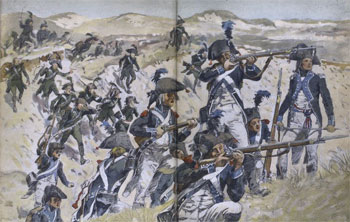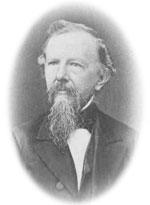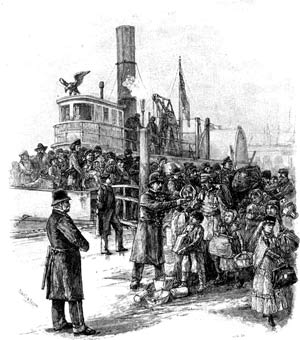In the middle of the nineteenth century, conditions in Europe were poor. Crops were failling all over Europe and many people hardly made enough money to feed their families. For this reason, many people decided to emigrate to the United States, where farmland was plenty and people hoped they could begin a new life. In the Netherlands, some people also had religious reasons to emigrate. The had seceded from the Dutch Reformed Church and were being oppressed by the goverment. The United States offered to them not only better economic prospects, but also the chance to celebrate their religion as they saw fit.
Economic reasons
The nineteenth century started with a lot of political turmoil. Under the leadership of Napoleon Bonaparte, the French had occupied the Netherlands in 1795. Several Dutch boys and men were drafted in Napoleon’s army and fought, and died, all over Europe. In 1815, Napoleon was defeated and the Netherlands became an independant kingdom. The peace wouldn’t last long. In 1830, the southern provinces wanted to start their own country. This started a civil war, ending with the independence of Belgium in 1831.

To pay for all these war exploits, taxes were high. In the 1840s, failed crops added to the problems. In 1845-1847, a potato blight deprived many people of their staple diet. In Ireland, this same blight caused the famous potato famine which cost the lives of millions of Irish people. In the Netherlands, many people were hungry as well. Children were put to bed with belts around their stomachs so they felt like they were full.
Religious reasons
In the early nineteenth century, more and more people did not agree with the doctrines of the Dutch Reformed Church. People wanted to be more devout and less liberal. This inspired the secession (Afscheiding) of the Reformed Church in 1834 and led to the formation of the ‘true’ reformed church in the Netherlands.
 As a counter-measure the Dutch government reinstated an old French law from the time of Napoleon, forbidding the assembly of a party larger than 20 people. Of course, in the gatherings of the Seceders, far more than 20 people were present, so both the preaching minister and the owner of the house where the ceremony took place were given severe fines or even sent to prison. The money to pay the fines was then raised by all the Seceders in the region. Another attempt to constrain the Secessionists was to have the soldiers’ quarters in the homes of the preachers and people where they came together.
As a counter-measure the Dutch government reinstated an old French law from the time of Napoleon, forbidding the assembly of a party larger than 20 people. Of course, in the gatherings of the Seceders, far more than 20 people were present, so both the preaching minister and the owner of the house where the ceremony took place were given severe fines or even sent to prison. The money to pay the fines was then raised by all the Seceders in the region. Another attempt to constrain the Secessionists was to have the soldiers’ quarters in the homes of the preachers and people where they came together.
Because of the problems with the Dutch government, the leaders of the Secession were thinking about emigration. Their ideal was to found a Dutch Seceded colony, where people were free to practice their beliefs. They would have their own churches, schools and teachers. Albertus van Raalte left with many of his followers and went on to found the best-known Dutch settlement in the United States, Holland, Michigan.
Emigration
In the 1840s, the emigration to the United States took off. A Winterswijk man wrote in his diary "People talk about America all the time now." Whether for economic reasons, religious reasons, or a combination of both, thousands of people emigrated. The first group emigrated mainly from 1844-1847 and then from 1854-1860. Why the emigration decreased after 1847 isn’t really known. Factors might be the better crops, the Phoenix disaster, and the growing tolerance for the Seceders in the Netherlands. The emigrants came predominantly from the provinces of Gelderland, Zeeland and Overijssel. They settled mainly around the Great Lakes, in the states of Michigan, Wisconsin and Iowa.

When the Civil War broke out in the United States, people became less interested in emigration again. Another emigration wave started in the 1870s and lasted until the 1920s when the Great Depression started and the immigration laws in the United States became more strict. The peak of the emigration took place in the 1880s. This time, many people from the provinces of Groningen and Friesland emigrated as well. Robert Swierenga estimates that between 1835 and 1880, between 75,000 and 100,000 Netherlanders came to the United States. Many of them settled in the Dutch settlements that had been established a generation before, but many others founded new communities in the western states.

